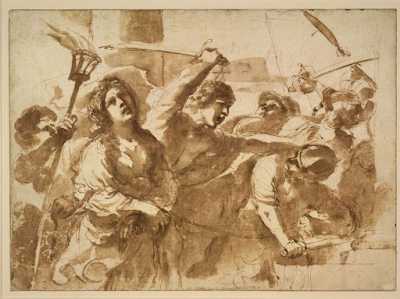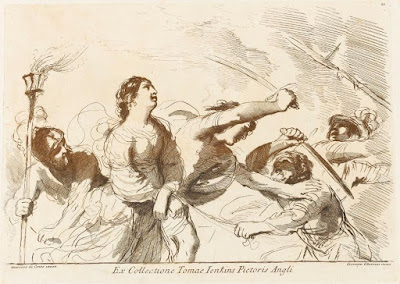 |
| Guercino (Giovanni Francesco Barbieri) Guardian Angel ca. 1624-26 oil on canvas Palazzo Colonna, Rome |
 |
| Giovanni Vitalba after Guercino Guardian Angel 1790 engraving after Guercino drawing Fine Arts Museums of San Francisco (Achenbach Foundation) |
"[Denis Mahon dated the Guardian Angel c. 1624-26], noting that the influence of Domenichino was perceptible in the monumental scale of the figures in relation to the picture space and in the crisp modelling of the draperies. This urge to achieve figures of greater formal clarity, he suggested, was motivated by Guercino's desire to shed the 'misty vapours' that had characterized his pre-Roman work."
 |
| Guercino (Giovanni Francesco Barbieri) Venus, Mars, Cupid and Time ca. 1624-26 oil on canvas (trial version) private collection |
 |
| Guercino (Giovanni Francesco Barbieri) Venus, Mars, Cupid and Time ca. 1624-26 oil on canvas (finished version) National Trust, Dunham Massey, Cheshire |
 |
| Matthijs Pool after Guercino Venus, Mars, Cupid and Time ca. 1696-1727 engraving after lost Guercino drawing Rijksmuseum, Amsterdam |
 |
| Guercino (Giovanni Francesco Barbieri) Capture of Cassandra and Slaying of Coroebus ca. 1625 oil on canvas National Trust, Charlecote Park, Warwickshire |
 |
| Guercino (Giovanni Francesco Barbieri) Capture of Cassandra and Slaying of Coroebus ca. 1625 drawing (compositional study) British Museum |
 |
| Giovanni Ottaviani after Guercino Capture of Cassandra and Slaying of Coroebus 1764 etching after Guercino drawing Staatsgalerie, Stuttgart |
 |
| Guercino (Giovanni Francesco Barbieri) Charity ca. 1625-26 oil on canvas Dayton Art Institute, Ohio |
 |
| Guercino (Giovanni Francesco Barbieri) Charity ca. 1625-26 drawing (compositional study) British Museum |
 |
| Guercino (Giovanni Francesco Barbieri) Charity ca. 1625-26 drawing (compositional study) Musée Condé, Chantilly |
 |
| Giovanni Battista Pasqualini after Guercino Charity 1626 engraving Rijksmuseum, Amsterdam |
"Pasqualini's dated engraving [directly above] of 1626, in reverse, corresponds closely to the Dayton picture [Charity], crediting Guercino with the design's invention. The canvas is in poor condition, with losses and surface abrasions consistent with an old, over-zealous restoration. Yet enough details survive, for example in the cushion and in Charity's drapery, to suggest that it is autograph. The modelling of the heads of the putti and their lighting are entirely characteristic, despite the loss of most of the finishing touches in the hair."
 |
| Guercino (Giovanni Francesco Barbieri) Samson presenting the Honeycomb to his Parents ca. 1625-26 oil on canvas (trial version) Galleria Borghese, Rome |
 |
| Guercino (Giovanni Francesco Barbieri) Samson presenting the Honeycomb to his Parents ca. 1625-26 oil on canvas (finished version) Chrysler Museum, Norfolk, Virginia |
"The present picture [Samson presenting the Honeycomb to his Parents in the Chrysler Museum] is thought to have been painted in the spring of 1626, before Guercino's departure for Piacenza. The Pope himself may have commissioned it, as Mahon surmised. If not, it might have been ordered by another member of the Barberini family, for it is recorded in several old Barberini inventories."
 |
| Guercino (Giovanni Francesco Barbieri) Assumption of the Virgin, with Sts Peter and Jerome 1626 oil on canvas Cattedrale di Santa Maria Assunta, Reggio Emilia |
"In 1624 Guercino began negotiating terms with the Cathedral Chapter for undertaking the present work. On 23 September 1624, the Cannons of Reggio formally entrusted Guercino with the task, and the painter signed the contract in person on 9 May 1625, when he was in Reggio to deliver his Crucifixion altarpiece to the Ghiara. The Assumption of the Virgin, with Sts Peter and Jerome was delivered on 10 January 1626, slightly later than originally agreed. With the figures ranged on three levels, each differently dressed in their respective identifying attire, the composition is something of an oddity. St Peter is seated on the left, occupying the lowest level, and is sumptuously dressed in the pontifical, with his tiara discreetly placed on a cushion on the floor; St Jerome kneels on a low platform behind St Peter and is nude, except for a large red cloak wrapped around his middle; and the Virgin, who is being transported to heaven on a cloud accompanied by a musical angel and two putti, fills the space above the gap between the two foreground figures, making her head the apex of a pointed triangle."
 |
| Robert Shipster after Guercino Assumption of the Virgin with Sts Peter and Jerome 1794 copy drawing after lost Guercino drawing British Museum |
– quoted texts from The Paintings of Guercino: a revised and expanded catalogue raisonné by Nicholas Turner (Rome: Ugo Bozzi Editore, 2017)